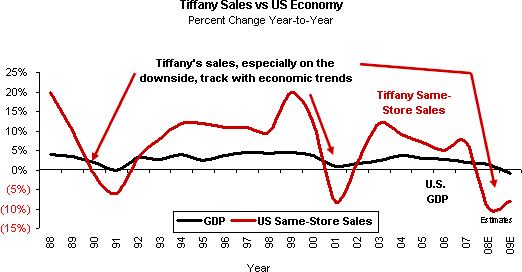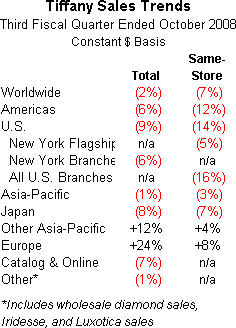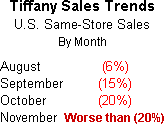IDEX Online Research: Tiffany’s U.S. Stores Feel Economic Downturn
December 08, 08
It’s official: high-end jewelers such as Tiffany & Co., the world-renowned jeweler, are feeling the weak economic environment. The media is using Tiffany’s sales as “Exhibit A” to prove that high-end jewelers’ sales are being hit hard in the current recessionary environment. Further, the media is claiming that this trend is a departure from prior recessionary periods.
The problem with these statements is that they are out of context, and they are partially false, especially for Tiffany. Here’s what actually happens:
- When the economy slows, jewelry sales decline sharply.
- When the economy slows, Tiffany’s sales show a greater rate of decline than the rate of decline for the economy.
- When the economy slows, mass market jewelers tend to feel the impact worse than high-end jewelers. But virtually all jewelers feel the impact of a weaker economy.
The graph below illustrates Tiffany’s U.S. same-store sales versus economic growth since 1988 (about when Tiffany became a public company). In the past two recessionary periods, Tiffany’s same-store sales fell at a greater rate than the economy slowed. In 2008 and 2009, we are predicting the same trend. The economic forecast is based on consensus numbers while Tiffany’s same-store sales forecast is based on our predictions.

Source: Tiffany & Co. Reports, US Dept. of Commerce
Tiffany’s Operating Profit Up, Despite Weak Sales
Here’s what is important about Tiffany’s results for the three-month period ended October 2008: the company posted a solid profit. Its operating margin this year was 12.7 percent versus an adjusted 10.1 percent last year.
Here’s what is different: most jewelers report a loss in the third quarter. In short, despite very weak economic conditions and highly disappointing sales levels in the U.S., Tiffany’s operating profits were up on an apples-to-apples basis in the quarter. The table below summarizes Tiffany’s third quarter financial results.

The following are highlights from the company’s third quarter ended October 2008:
- Sales were disappointing in all of Tiffany’s markets, except the Asia-Pacific region (excluding Japan) and Europe. The table below summarizes total sales and same-store sales by operating division for the three-months ended October 2008.

Source: Tiffany & Co.
- In the U.S., sales deteriorated as the quarter wore on. In August, same-store sales declined by 5 percent. By the end of the quarter, U.S. same-store sales were down 20 percent. Management said that November sales trends were worse than October sales levels. Tiffany’s branch same-store sales declined by 21 percent in October. The following table summarizes Tiffany’s same-store sales by month in the U.S. market.

Source: Tiffany & Co.
- Tiffany management cited three key reasons for its sluggish sales: 1) a slowing global economy; 2) frozen credit markets; and 3) plummeting equity markets.
- The substantial sales decline in the U.S. market was broad-based. However, sales in Tiffany’s flagship Fifth Avenue store declined only slightly, since overseas customers helped maintain demand. Unfortunately, now that the U.S. dollar has risen against most of the world’s currencies, America and American goods are no longer “on sale” to overseas visitors.
- The average transaction size rose slightly in the U.S. market. Management did not disclose the actual dollar amount of the average transaction.
- A price stratification analysis showed weakness in sales and transactions across the board at most price levels with no meaningful differences.
- E-commerce and catalog sales declined by 7 percent in the quarter due to fewer orders. However, the average transaction value rose somewhat.
- Retail sales in Canada, Mexico and Brazil were up double-digit percentages in the quarter. Online sales in Canada were strong.
- Sales in Tiffany’s Iridesse pearl stores declined, and were below expectations.
- Statement jewelry sales were down in the quarter, though they rose slightly in overseas markets.
- Sales of fine jewelry collections declined modestly worldwide for Tiffany, dragged down by weak demand in the U.S. However, sales of collections rose in other global markets, especially in the Asia-Pacific region.
- Worldwide engagement jewelry sales rose by a single digit level, but posted a small decline in the U.S. market. However, Tiffany reported strong growth in wedding bands.
- At more modest price points, fashion jewelry sales were up in the quarter due to strong demand for silver and gold charm jewelry collections, with particular strength in Europe.
- Designer jewelry sales were down in the quarter, with pronounced softness in the U.S.
- While watch sales were soft, management continued to talk up its strategic alliance with the Swatch Group. This alliance should add meaningfully to Tiffany’s 2009 watch offerings.
- Tiffany’s gross margin rose to 56.3 percent in the third quarter, nearly two points higher than last year’s 54.4 percent. Four key factors helped the company maintain its gross margin, despite intense competition for consumers’ discretionary income: 1) favorable changes in the company’s sales mix; 2) benefits from precious metals hedging; 3) reduced reserve for incentive compensation; and 4) the lack of price-based promotions. Tiffany’s management reiterated its opposition to price-based promotions.
- Tiffany provided guidance to Wall Street investors as follows:
- Fourth quarter U.S. same-store sales are likely to be down 25-35 percent.
- Fourth quarter worldwide sales are expected to decline by 13-20 percent.
- Total annual global sales (fiscal year ending January 2009) are expected to be about flattish to down 2 percent.
- The company’s gross margin is expected to rise moderately for the full year.
- Full-year earnings per share are expected to be about flat. However, this assumes that there are fewer shares outstanding, so net after-tax profits are expected to be down modestly for the full year.
- Management also said that they planned to “reduce staffing”; these are code words for “implement layoffs of people.” Frankly, we are surprised that they have waited until now. Typically, we would have expected Tiffany to react more quickly.
- While Tiffany management remains committed to new store expansion, it is reducing its long term rate of growth from 8-10 percent annually to 5-6 percent in 2009. This will probably mean 4-5 new stores in the U.S., versus a historical rate which would be closer to 8-9 new stores.
The following table summarizes Tiffany’s expansion for the past twenty years. The years highlighted in yellow are recessionary periods. Historically, Tiffany has slowed its expansion during recessions, but often opens mores stores just as the recession is ending. Thus, it will be well-positioned for a potential recovery.

Source: Tiffany & Co.